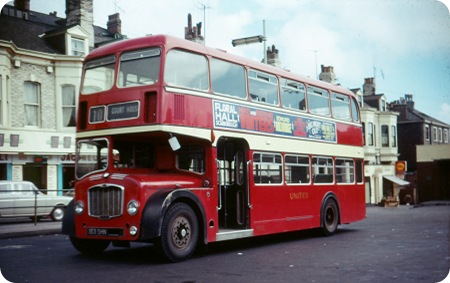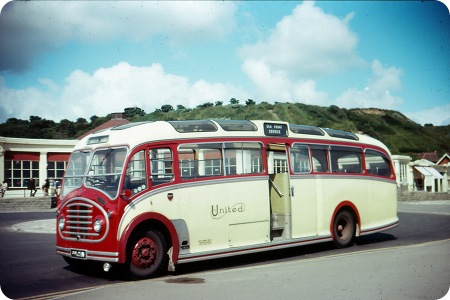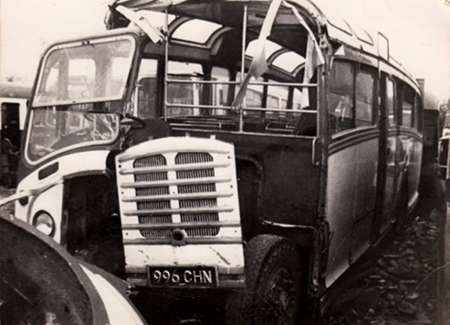
United Automobile Services
1964
Bristol Lodekka FLF6B
ECW H38/32F
I am not sure if the Lodekka actually had a version number i.e. I, II, III as the Regent III, V for example if any body knows please let me know. I did like these front entrance Lodekka’s, the three things I remember most is the low step to get on, how brightly light the interior was at night but best of all was the whine of the engine, being used to AEC and Leyland’s at home the Bristol or Gardner engines were very different.
A full list of Bristol codes can be seen here.
A full list of United codes can be seen here.
———
The best United engine noises of all were the final batch of Bristol FLF Lodekkas delivered between January and May 1968. These F-registered machines were fitted with Gardner engines and were the first non-Bristol engined buses in the fleet. A Bristol-type whine was accompanied by a very powerful growl as I remember – very impressive. Also, this final batch were even brighter inside than normal. The interior panelling was finished in all-over cream formica as opposed to the normal dark green which made them feel light, spacious and very modern. They were lovely vehicles to ride on!
Incidentally, you may like to know that I am the author of a book on United’s buses entitled ‘One And Two Halves To The Clock’, which is my own story of growing up as a lad in the 1960s in Redcar, North Yorkshire – a seaside town deep in United territory!
Colin Plucknett
———
Although Lodekkas did not have version numbers as such (ie: Series I, II, III etc), they were split into two broad types – namely LD and F-Series models. The original LD (Low-height Double-decker) series had a slightly sunken lower deck gangway, with the pairs of seats either side of it in effect raised above it. A longer version (LDL) made its debut in 1957, but only a handful were built. As the Lodekka developed over the years, a revised model was introduced. Known as the F (Flat floor) Series, this had as the name implied, a flat floor throughout the lower deck. It was available in four variants: FS (Flat floor, Standard/Short chassis); FL (Flat Floor, Long chassis); FSF and FLF (as for FS and FL, but with the second F denoting a forward entrance chassis). Interestingly, the Bristol BVW engine fitted to many a Lodekka from 1958 onwards did have version numbers. As the BVW evolved, engines became known as Series I, II and III, and could be identified by the serial number stamped on the engine plate. BVW1xxx denoted Series I, BVW2xxx were Series II, and BVWs numbered 3xxx/4xxx etc were Series III.
Brendan Smith
———
There was a final variation to the FLF series: the very impressive 31ft FLF6LX models, with semi-automatic gearboxes, as operated by Eastern National. Several of them started life with coach seating for the X10 Southend-London Victoria service. In their heyday, around 24 of the 40 plus that ENOC had were allocated to the long 151/251 working from Southend to North London (Wood Green): a 2hr 40min one way trip! Also, one or two were regularly featured on the "On the Buses" TV show.
As a Conductor, these were wonderful vehicles to work on, especially on the long haul routes. I also believe the Scottish Bus Group had some as well. They’re the only two operators I know that used them. Any others, anyone?
Mike Harper
———
05/06/11 – 14:28
Eastern National’s FLF coaches certainly were real stunners Mike, and the 31-footers were handsome machines in either bus or coach form. As you rightly say, several of ENOCs Wood Green FLF6LXs featured in ‘On the Buses’ and were to many of us the real stars of the show. (I wonder if Reg Varney and Doris Hare realised just how privileged they were to work alongside such venerable icons!). At least AEV811F and AVW399F took part in the series masquerading as buses of the Luxton & District Traction Company – and wasn’t it a quirk of fate that the ‘AVW’ registration was on a Gardner-powered bus? You are correct in saying that only ENOC and the Scottish Bus Group took delivery of 31-footers – sadly for some reason they didn’t find favour anywhere else.
Relating to the semi-automatic FLFs, I was fortunate enough to ride on Leyland 0.600 engined Hants & Dorset example when on holiday with friends in the 1970s. I had not realised the FLF had either feature until it started up and set off. The pronounced gear whine puzzled me, and it was only in later years I found out this was due to extra gearing in the transmission line. On manual gearbox Lodekkas the gearbox was mounted directly behind the engine, with the drive being taken downwards and slightly to the offside by the design of the gearbox. However, as the semi-auto ‘box was of a bulkier nature, this unit was mounted on the offside of the chassis. The drive was taken downwards and to the offside from the back of the flywheel to the gearbox, using a train of gears – hence the unusual whine emitted. It certainly added a certain character!
Brendan Smith




